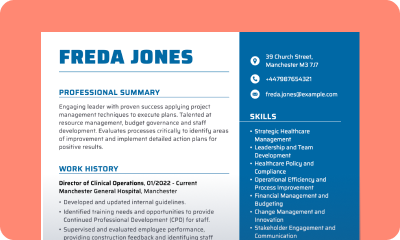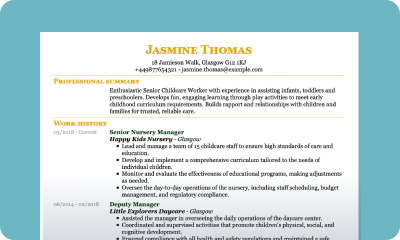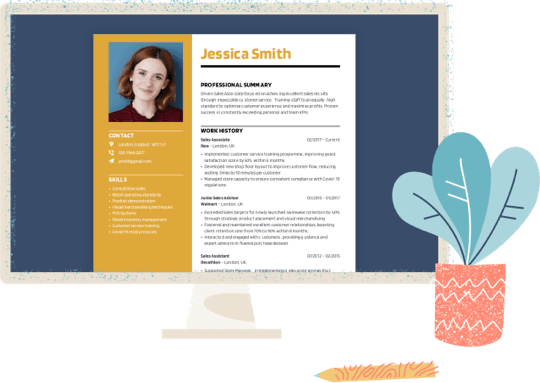- Our customers have been hired by : * Foot Note
A successful job search in the UK begins with the right CV format. Our British CV templates for download are designed to reflect UK hiring standards, helping you showcase your achievements and strengths. With My Perfect CV, you’ll build a CV that recruiters love to see.
people are creating their CV with My Perfect CV now
*The number shown results from a predefined calculation based on the average yearly traffic. The actual number may differ.
UK CV examples
The British job market is both diverse and competitive. Have a look at a few British CV examples for different jobs, industries, and experience levels that feature our UK CV templates.
British CV formats
Before you set about writing your CV, you need to know what format to go for. In the UK, there are 2 main CV formats to choose from:
Chronological CV
This is the most common format in the UK. It lists your work experience in reverse chronological order, starting with your most recent role. Employers like it because it clearly shows your career progression and responsibilities over time. It’s best suited for candidates with consistent work history and relevant experience in their field.
Skills-based CV
Also called a functional CV, this format highlights your core skills and abilities rather than your work history. It’s useful for students, career changers, or those with gaps in employment. Grouping skills with supporting examples helps recruiters see your potential even if you don’t have extensive experience.
Free British CV template
Ben Worthington
Mechanical Technician
14B Crown Way, London W5 0FR
07912 345 678
ben.Worthington@example.co.uk
Professional summary
Dedicated Mechanical Technician with 10+ years of experience maintaining, testing, and optimising industrial systems. Skilled in diagnosing mechanical issues, reducing downtime, and improving operational efficiency. Recognised for implementing safety protocols and delivering measurable results in high-pressure environments.
Work history
Field Mechanical Technician
Fliers & Macs, London
January 2020 – December 2025
- Performed preventative maintenance, reducing unplanned breakdowns by 25% over three years.
- Conducted root cause analysis on system failures, improving repair efficiency by 30%.
- Responded to mechanical outages within an average of 45 minutes, increasing plant availability by 15%.
- Implemented Integrated Safe System of Work (ISSoW) process, improving compliance with safety audits by 20%.
Rail Mechanical Technician
Mechs, London
February 2015 – December 2019
- Designed and tested new components, cutting defect rates by 18%.
- Built and assembled electro-mechanical units and breaker cabinets for rail systems, contributing to a 10% increase in project delivery speed.
- Supported high-volume production lines, increasing throughput by 12% through process improvements.
- Established a defect reporting system, reducing repeat mechanical issues by 22%.
Education
NVQ Level 3 Diploma in Mechanical Manufacturing Engineering
Graduated in 2010
University of London, London
Skills
- Pneumatic systems and diagnostics
- Occupational health and safety compliance
- Gearbox assembly and maintenance
- Hydraulic systems troubleshooting
- Bearing installation and repair
- Industrial testing equipment operation
- Communication skills
- Time management skills
- Problem-solving
How to use a British CV template
Before you start filling in your chosen template, it’s important to understand what to include in a CV. A British CV has a well-established structure that helps recruiters quickly scan your information and decide whether you’re a strong fit.
Contact information
Your contact details should sit at the very top of your CV and be easy to find at first glance. This section is purely practical but absolutely essential. If recruiters can’t reach you, the rest of your CV won’t matter. Include:
- Full name – avoid nicknames; use the professional version you’d want on official documents.
- Job title – tailor this to the role you’re applying for (e.g., Mechanical Technician or Marketing Graduate).
- Phone number – your personal, active mobile number.
- Email address – keep it professional, ideally firstname.lastname@email.com.
- Location – city and postcode are enough; no need for your full address.
- Professional links – such as LinkedIn or an online portfolio, if relevant to the role.
Personal statement
The personal statement (sometimes called a CV profile or summary) is the first impression recruiters will have of you beyond your contact details. It’s a short paragraph, usually 3–5 sentences, that sums up who you are, what you offer, and what you’re aiming for. When writing your personal statement:
- Tailor it to the role – highlight qualities and experience that match the job description.
- Include a quantified achievement – recruiters love measurable results, such as “reduced production downtime by 25%” or “increased sales revenue by £50,000 annually.”
- Keep it concise – no more than 100 words. Clarity and impact are more valuable than length.
- Show your value – rather than what you want, focus on what you can deliver for the employer.
Work experience
Your work experience is often the most important part of a British CV. This section shows recruiters how your past roles have prepared you for the position you’re applying for. List your roles in reverse chronological order, starting with the most recent. For each role, include the job title, company name, location, and dates of employment.
To make your CV stand out, don’t just list duties — focus on achievements. The best way to do this is by using the STAR method (Situation, Task, Action, Result). This allows you to clearly show what challenge you faced, what you were responsible for, the actions you took, and the results you achieved.
Always cross-check your bullet points with the job description. Tailor your examples to highlight the skills and achievements the employer is looking for. Three to six bullet points per role are enough to demonstrate your impact without overwhelming the reader.
Skills section
The skills section of a British CV is your chance to showcase the abilities that make you a strong candidate. This section is especially important if you’re early in your career or changing industries, as it highlights what you can do even when experience is limited. There are two main types of skills to include:
- Hard skills – These are technical, job-specific abilities that can be measured or proven, such as data analysis, coding, bookkeeping, AI skills, or proficiency in software like AutoCAD or Excel.
- Soft skills – These are interpersonal qualities that describe how you work with others and manage tasks. Examples include communication skills, teamwork, adaptability, and leadership.
When listing your skills:
- Tailor them to the job description, emphasising the ones the employer values most.
- Support key skills with short evidence, if possible, such as “Project management – led a team of 5 to deliver a system upgrade two weeks ahead of schedule.” This step is necessary if you’re writing a skills-based CV.
- Aim for 6–10 well-chosen skills, grouped logically if your template allows.
Education section
The education section is a core part of a British CV, particularly for students, recent graduates, or professionals applying to roles where qualifications are essential. Employers want to quickly see your academic background and how it supports your suitability for the role. Include the following details for each qualification:
- Degree or qualification title – e.g., BSc Mechanical Engineering or A-Levels in Maths, Physics, and Chemistry.
- Institution name and location – keep it clear and concise.
- Dates of study or graduation – month and year are usually enough.
- Grades or results – list your grade if it strengthens your application (e.g., First-Class Honours or AAB).
If you don’t have much work experience, you can expand this section by including relevant coursework, research projects, or dissertations to demonstrate knowledge and transferable skills. However, if you’re more experienced, keep it brief and prioritise your work history instead.
Bonus sections
While not mandatory, bonus sections can make your British CV more compelling by highlighting additional strengths beyond your core qualifications and work history. Common bonus sections to consider include:
- Certifications – Professional credentials such as PRINCE2, CIPD Level 5, or First Aid Certification add credibility.
- Languages – List any additional languages you speak, ideally with a recognised framework like CEFR (e.g., Spanish – B2).
- Volunteering – Community work or unpaid experience demonstrates transferable skills such as teamwork, organisation, or leadership.
- Awards and honours – Academic prizes, industry recognition, or workplace awards can help set you apart.
- Projects – Major personal or professional projects that show relevant expertise, such as launching a website or leading a research initiative.
- Professional memberships – Organisations like the Chartered Institute of Marketing (CIM) or Institution of Mechanical Engineers (IMechE) demonstrate engagement with your field.
When adding bonus sections, keep them concise. 2–4 bullet points per category is usually enough. Always prioritise the ones most relevant to the role you’re applying for.
British CV template dos and don’ts
DO
Do research on British CV examples in your field.
Look at a British CV template that matches your profession to understand what employers expect. For example, a construction manager CV will emphasise leadership achievements and training, while a dance CV might highlight performances, awards, and creative skills.
Do use correct British English.
Always tailor your CV to UK standards. Words and education terms differ across countries — for instance, “college” in the UK refers to post-16 education, not university as in the US. Using correct terms shows professionalism and cultural awareness.
Do follow the right structure.
A British CV template usually starts with contact details, followed by a personal statement, work history, skills, and education. Use bullet points for clarity, and tailor each section to the job description.
Do tailor your CV for each application.
Recruiters look for evidence that you’re suited to their role. Adapt your personal statement, skills, and achievements to match the employer’s requirements every time.
DON'T
Don’t use the wrong CV format.
The British CV format is typically reverse chronological, with work experience listed from most recent to oldest. Avoid creative layouts that confuse ATS software, and keep your CV within two A4 pages.
Don’t ignore differences in UK qualifications and experience.
If you have qualifications from outside the UK, be clear on how they make you suitable for the position. For example, if you’re creating a CV template for UK warehouse operative jobs, you might need to specify or even translate what certain non-UK qualifications are and how they correspond to similar UK accreditations.
Don’t overload with irrelevant information.
Leave out details like your age, unrelated hobbies, or jobs you had over 15 years ago. Stick to professional, role-specific achievements that add value to your application.
Don’t forget to proofread.
Typos, formatting errors, or inconsistent styles can undermine even the best experience. Always double-check your British CV template before sending it to employers.
FAQ: British CV templates
What is the difference between a British CV and an American resume?
A British CV is typically longer and more detailed than an American résumé. While a résumé in the US is usually one page, a British CV can extend to two pages to cover work history, education, and skills in greater depth. Another key difference is that British CVs always use British English and are tailored to UK hiring standards.
How long should a British CV be?
The ideal CV length in the UK is no more than two A4 pages. Most employers prefer concise, relevant information that highlights your achievements, skills, and work history. For entry-level roles, a one-page CV may be sufficient, but for more experienced professionals, two pages is the standard.
Do your British CV templates work with Applicant Tracking Systems (ATS)?
Yes, all of our British CV templates are ATS-friendly. This means they use clean formatting, standard section headings, and simple layouts that Applicant Tracking Systems can easily scan. By using one of these templates, you reduce the risk of your CV being filtered by AI before reaching a recruiter.
Do I need to include a photo on a British CV?
No, you should not include a photo on a British CV. Unlike CVs in some European countries, UK employers prefer applications without photos to reduce the risk of bias.
Should I include references on my British CV?
No. Current best practice is to omit references and skip the outdated line “References available on request.” If the company requests references, attach a recent reference letter, list, or link to verified recommendations.
Is a cover letter required with a British CV?
Yes, it’s always recommended to include a cover letter when applying for jobs in the UK. While your CV outlines your skills and experience, a cover letter lets you explain your motivation, provide further context, and make a more personal connection with the employer.
Find the perfect CV template for UK employment in our collection
If you’re looking to find work in the UK, having a fantastic British CV template makes a world of difference. Rather than wasting time creating and formatting a CV from scratch, you can immediately input all your qualifications and experience. Whether you need a British CV template in Word or a British CV format in PDF, you’ll find exactly what you’ve been searching for in My Perfect CV’s wide selection of UK CVs. Discover the perfect CV template for UK jobs and land that interview you’ve always dreamed of.
*The names and logos of the companies referred to above are all trademarks of their respective holders. Unless specifically stated otherwise, such references are not intended to imply any affiliation or association with myperfectCV.





